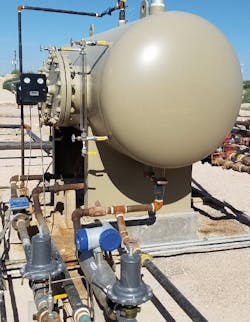Latest from Best Practices
Sponsored
Using Electromagnetic Flowmeters for Better Management of Produced Water
The oil and gas industry is increasingly relying on electromagnetic flowmeters, commonly known as magmeters, as a crucial tool to address the ever-growing challenges of managing produced water—the water that is brought to the surface during oil and gas extraction operations. Not only is the volume of produced water surging, but at the same time, the industry faces mounting constraints on its use and disposal.
These growing financial and environmental pressures have heightened the importance of accurate and reliable measurement of produced water flow at every stage—from extraction and separation to transportation, treatment, and eventual re-use or disposal. Consequently, the industry is transitioning from conventional mechanical meters to intelligent electromagnetic flowmeters, enabling more efficient and effective management of produced water.
Surging Volume of Produced Water
The dramatic growth in the volume of produced water in North America follows the overall expansion of oil and gas extraction activities. As global energy demands intensify, the industry continuously seeks out new reserves and employs methods to tap into previously inaccessible oil and gas fields.
Extraction methods now include the exploitation of unconventional reserves such as shale formations, which often involve hydraulic fracturing or fracking. This process requires large volumes of water to fracture the shale rock and release hydrocarbons, leading to a significant increase in the quantity of water that needs to be managed after the extraction process.
Another important factor contributing to the rise is that as fields mature, more water is produced for each volume of oil or gas extracted.
Changing Perspectives
Previously considered an inconvenient byproduct, produced water has begun to be recognized as a critical component of the industry's operations. This evolving view of produced water in part reflects a broader shift toward a more sustainable and circular economy approach within the oil and gas industry.
Advances in technology enable more effective treatment and use of produced water, potentially transforming it from a cost center to a potential asset. Some companies are exploring innovative ways to convert the water’s constituents into valuable products or for reuse in operational processes.
Increasingly, in the USA and elsewhere around the world, federal, state or local governments endeavor to effectively manage produced water to safeguard surface and groundwater resources while alleviating the future demand for fresh water. By pursuing the pollution prevention hierarchy of "Reduce, Reuse, and Recycle," the industry is exploring traditional and innovative approaches including the reuse of treated produced water for irrigation of non-edible agriculture, such as cotton or biofuel crops.
In addition to protecting freshwater resources, regulators seek to mitigate seismicity risks by imposing stringent production limits and requiring strict monitoring and precise measurement of the water injected as part of the oil and gas extraction process since it has been determined that reinjection of water can exert stress on fault lines and potentially cause earthquakes.
Meticulous Monitoring
Therefore, accurate measurement of water is crucial at every stage. The quantities must be reconciled to ensure no loss occurs at any point of the process. This meticulous monitoring helps maintain water integrity and sustainability throughout its lifecycle.
Moreover, accurate flow measurement is essential for controlling costs and ensuring optimal operational efficiency. This is particularly evident in the transportation and treatment of produced water. Transportation, especially when done by truck, represents a significant expense and requires effective flow management. The treatment of produced water, removing the cocktail of organic and inorganic compounds, also necessitates precise flow measurement to maintain cost-efficiency and operational effectiveness.
Magmeters: Ideal for Measuring Produced Water
The operational principle of electromagnetic flowmeters makes them particularly well-suited to flow measurement in produced water applications in the oil and gas industry due to the saline nature of the water.
Magmeters function based on Faraday's Law of electromagnetic induction, where the voltage induced is directly proportional to the speed of the fluid, the magnetic field's strength, and the length of the conductor. In a magmeter, the salty water serves as the conductor. Since produced water is high in salinity, it enhances the electrical conductivity of the water, leading to highly accurate measurement.
Moreover, the non-intrusive design of magmeters enables them to operate efficiently even in corrosive saline water environments, without experiencing degradation. As a result, they provide a cost-effective and dependable solution for managing and monitoring produced water systems.
Transition from Mechanical Flowmeters
While mechanical flowmeters have traditionally been a common choice for measuring produced water, an increasingly rapid transition towards electromagnetic flowmeters is occurring in new installations and repair/replacement scenarios.
This transition is motivated by vastly improved accuracy, reliability, longevity, and ease-of-maintenance. Moreover, electromagnetic flowmeters offer additional capabilities such as online diagnostics, and data collection, making them a compelling choice. Due to their accuracy and reliability, they can also be used for leak detection.
Accuracy, Reliability and Ease-of-Maintenance
First and foremost, electromagnetic flowmeters are completely electronic, eliminating the need for any moving parts. This makes them far more robust and less prone to wear and tear, thereby reducing the need for frequent maintenance and replacement. As a result, they have an exceptionally long lifespan. Krohne has magmeters that have been in service for over 25 years, continuing to provide accurate flow measurement of produced water.
Second, electromagnetic flowmeters offer better accuracy compared to their mechanical counterparts. Mechanical flowmeters can be affected by the viscosity of the fluids they measure, which can lead to inaccuracies. On the other hand, electromagnetic flowmeters are independent of fluid properties such as viscosity, temperature, and pressure, offering more reliable readings.
Third, magmeters offer significantly easier maintenance compared to mechanical flowmeters. The latter necessitate frequent maintenance, including an annual check and periodic removal from the line. Internal components require inspection, replacement, and often need to be sent for rebuilding. Available information within the magmeter can also be periodically monitored to alert the user of any potential issues, such as electrode wear or coating or even a degradation of the liner in extreme conditions, without having to take the meter out of service.
Electronic and Smart Capabilities
The intrinsic electronic nature of magmeters enables the seamless integration of essential, groundbreaking smart functionalities that are beyond the capabilities of mechanical flowmeters.
Leak Detection. Advanced leak detection is a key smart feature of magmeters that adds significant value over mechanical meters. These sophisticated devices are capable of continuously monitoring the flow rate and identifying discrepancies, which can indicate a leak within the system. By doing so, magmeters can alert operators to even small leaks that might go unnoticed with less sensitive devices. Moreover, when combined with a relatively simple mass balance system, the magmeters can also provide information about the location, extent, and severity of the leak, allowing for prompt action to be taken when needed and avoiding false alarms that waste resources.
Online Diagnostics. These intelligent devices can self-monitor and provide operational status updates, ensuring they are functioning correctly and alerting maintenance personnel to any irregularities. The online diagnostics perform health checks on the meter, detecting issues such as electrode fouling, liner deformation, and ensuring accuracy within factory specifications.
This proactiveness empowers operators to address issues before they escalate, avoiding costly downtime and enhancing overall system reliability. Mechanical meters offer no such visibility: if the reading appears inaccurate, the entire meter must be removed from the line for maintenance.
Magmeters not only provide continuous monitoring of the meter's performance, but also continuously track variations in the qualities of the water passing through, including the water's conductivity.
Data Collection and Analytics. Mechanical meters typically only provide a flow rate reading, but electronic magmeters can record and store a wealth of data over time. This information can be used for detailed analysis, optimizing system performance, and improving resource management through trends and patterns identification. The integration of magmeters with industrial Internet of Things (IoT) platforms can also facilitate remote monitoring and advanced data analytics for strategic decision-making.
Selecting a Magmeter
When measuring produced water, it's important to consider that magmeters are not the only type of meter required. While magmeters are well-suited for water lines, Coriolis meters are more ideal for oil lines, and Ultrasonic or Coriolis meters are commonly used for gas lines. To ensure efficiency and avoid redundancy, incompatibility, and training hassles, it is wise to take an integrated approach by leveraging the same electronics to manage all meters in your portfolio. With instrumentation and metering systems from a single vendor, operators can rely on seamless integration of all components.
Similarly, it is advisable to select a vendor who offers a full range of magmeters that can meet all your specific requirements. For instance, it is important to have a vendor whose product range includes high-pressure magmeters specifically designed for injection wells. By considering these factors, you can optimize the performance and effectiveness of your metering systems.
Looking forward
In conclusion, the oil and gas industry is turning to magmeters as a vital solution to tackle the increasing challenges of managing produced water. With the surge in volume and mounting constraints on its use and disposal, accurate and reliable measurement of produced water flow is of utmost importance.
This has led to a transition from conventional mechanical meters to intelligent electromagnetic flowmeters, empowering more efficient and effective management of produced water throughout its lifecycle. By embracing these advancements, the industry can navigate the financial and environmental pressures while ensuring sustainable practices in water management.
Ron Garcia is Strategic Business Director for the KROHNE Group, a world-leading manufacturer and supplier of solutions in industrial process instrumentation.
Ron Garcia
Ron Garcia is Strategic Business Director for the KROHNE Group, a world-leading manufacturer and supplier of solutions in industrial process instrumentation.



